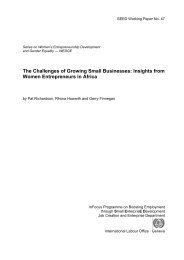manual: women workers' rights and gender equality - International ...
manual: women workers' rights and gender equality - International ...
manual: women workers' rights and gender equality - International ...
Create successful ePaper yourself
Turn your PDF publications into a flip-book with our unique Google optimized e-Paper software.
Briefing Note 5 Gender Planning: Steps for Action 20<br />
Step 1: Carry out a <strong>gender</strong> analysis<br />
• what are the roles <strong>and</strong> activities of men <strong>and</strong> <strong>women</strong> <strong>and</strong> what is the division of work between<br />
them<br />
• how are resources <strong>and</strong> benefits distributed among men <strong>and</strong> <strong>women</strong><br />
• what are the needs of men <strong>and</strong> <strong>women</strong><br />
• are there imbalances or inequalities between men <strong>and</strong> <strong>women</strong>, if yes, what are these<br />
Step 2: Give equal chances to men <strong>and</strong> <strong>women</strong><br />
• respect for the human dignity of children, <strong>women</strong> <strong>and</strong> men<br />
• equal opportunities to education, information, knowledge <strong>and</strong> services<br />
• equal sharing of duties (in the household <strong>and</strong> voluntary work for the community)<br />
• deciding together, not alone: involvement of both men <strong>and</strong> <strong>women</strong> in decision-making<br />
Step 3: Give <strong>women</strong> a voice<br />
• listen to <strong>women</strong> in the family <strong>and</strong> in meetings<br />
• organize meetings in a place <strong>and</strong> at a time that <strong>women</strong> can attend<br />
• setting up of <strong>women</strong>’s committees is good, if <strong>women</strong> are not allowed to speak in mixed<br />
gatherings or meetings. This enables them to gain confidence, for example in public speaking<br />
• ensure <strong>women</strong>’s representation in mixed committees. Keep in mind that only one or a few<br />
<strong>women</strong> is not enough. Generally, the male/female ratio of representation should range between<br />
40 <strong>and</strong> 60 per cent. A h<strong>and</strong>y ground rule is to ensure a representation rate of around 30 per<br />
cent of each sex as a minimum; otherwise it becomes difficult for those in the minority to<br />
effectively have a voice. When the aim is to increase <strong>women</strong>’s role in decision making, for<br />
example in project steering committees, or in training of trainers’ activities: allocate two-thirds<br />
of the available positions for <strong>women</strong> <strong>and</strong> one-third for men.<br />
Step 4: Address <strong>gender</strong> inequalities<br />
• set targets for girls’ <strong>and</strong> <strong>women</strong>’s, boys’ <strong>and</strong> men’s participation, for example, in education <strong>and</strong><br />
training<br />
• organize <strong>gender</strong> awareness training in communities to enable men <strong>and</strong> <strong>women</strong> to more equally<br />
share duties <strong>and</strong> responsibilities in the family <strong>and</strong> community<br />
• develop special measures <strong>and</strong> activities for <strong>women</strong> to advance their position (literacy training,<br />
confidence building, provision of credit)<br />
20 Report of Workshop on Participation of Indigenous Men <strong>and</strong> Women in Development (11-13 December 2000,<br />
Chiangmai, Thail<strong>and</strong>), Nelien Haspels, ILO/EASMAT, 2001.<br />
145

















